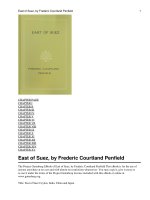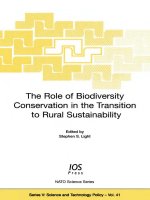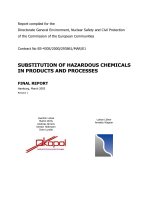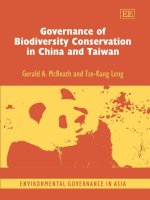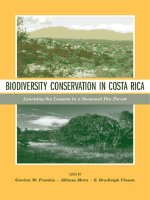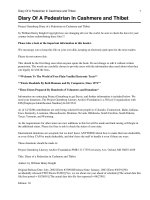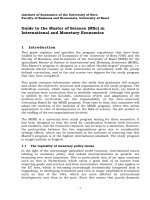Governance of Biodiversity Conservation in China and Taiwan pot
Bạn đang xem bản rút gọn của tài liệu. Xem và tải ngay bản đầy đủ của tài liệu tại đây (1.54 MB, 253 trang )
Governance of Biodiversity Conservation
in China and Taiwan
Governance of
Biodiversity
Conservation in China
and Taiwan
Gerald A. McBeath
University of Alaska Fairbanks, USA
Tse-Kang Leng
National Chengchi University, Taipei, Taiwan
ENVIRONMENTAL GOVERNANCE IN ASIA
Edward Elgar
Cheltenham, UK • Northampton, MA, USA
© Gerald A. McBeath and Tse-Kang Leng 2006
All rights reserved. No part of this publication may be reproduced, stored in a retrieval
system or transmitted in any form or by any means, electronic, mechanical or
photocopying, recording, or otherwise without the prior permission of the publisher.
Published by
Edward Elgar Publishing Limited
Glensanda House
Montpellier Parade
Cheltenham
Glos GL50 1UA
UK
Edward Elgar Publishing, Inc.
136 West Street
Suite 202
Northampton
Massachusetts 01060
USA
A catalogue record for this book
is available from the British Library
Library of Congress Cataloguing in Publication Data
McBeath, Gerald A.
Governance of biodiversity conservation in China and Taiwan / Gerald A.
McBeath, Tse-Kang Leng.
p. cm. — (Environmental governance in Asia series)
Includes bibliographical references and index.
1. Biological diversity conservation—China. 2. Biological diversity
conservation—Taiwan. I. Leng, Tse-Kang. II. Title. III. Series.
QH77.C6M33 2006
333.95'160951—dc22
2005032810
ISBN-13: 978 1 84376 810 4
ISBN-10: 1 84376 810 0
Printed and bound in Great Britain by MPG Books Ltd, Bodmin, Cornwall
Contents
List of figures vi
List of tables vii
Authors viii
Acknowledgments ix
1. Introduction 1
2. Historical patterns 18
3. Current status of species and ecosystems in China and Taiwan 39
4. Legal and institutional framework for biodiversity conservation 68
5. Protected areas and biodiversity conservation 100
6. Business organizations and biodiversity conservation 134
7. ENGOs, civil society and biodiversity conservation 159
8. Politics and biodiversity conservation 192
9. Conclusions 220
Index 233
v
Figures
1.1 Map of China 6
3.1 Important areas of vertebrate diversity in China 47
5.1 China’s protected area system 104
5.2 Taiwan’s protected areas 122
8.1 Location of Tainan and Qigu (Chiku) 199
8.2 Nujiang Development Region 210
vi
Tables
1.1 Comparison of China’s species to world total 7
1.2 Taiwan’s species compared to world total 8
2.1 Environmental problems in Taiwan 34
3.1 Distribution of species across China’s provinces 44
3.2 Threatened status of Chinese species 48
3.3 China’s afforestation programs since the 1970s 56
4.1 Government agencies and their functions in biodiversity
conservation 91
5.1 Type of nature preserves 105
5.2 Agencies managing nature reserves 106
5.3 Categories of protected areas in Taiwan 121
6.1 Cross-strait trade values (1997–2005) 150
6.2 Taiwanese investment in mainland China 150
6.3 Taiwanese investment in mainland China by sectors
(1991–2005) 153
7.1 Characteristics of the Three Waves of Environmentalism 160
7.2 Taiwan’s ENGOs (2005) 170
7.3 China’s ENGOs (2005) 173
vii
viii
Authors
Gerald A. McBeath is professor of political science at the University of Alaska
Fairbanks, where he has taught and done research since 1976. He studied at
the University of Chicago (AB, 1963; AM, 1964) and the University of
California at Berkeley (PhD, political science, 1970). His publications include
books and articles on Alaska State and local government, federalism, the
Chinese living abroad, the foreign relations and political economy of Taiwan
and China, and environmental politics (both US domestic and comparative).
He began research on this book while a Fulbright Professor at China Foreign
Affairs University in Spring 2004, and returned for follow-up study in
December 2004–January and May 2005. He is responsible for most of the
China sections in the study.
Tse-Kang Leng is professor of political science at National Chengchi
University, Taipei. He has served as the Secretary General of the Chinese
Association of Political Science since 2003. He studied at National Chengchi
University (BA, 1987), George Washington University (MA, international
affairs, 1991) and the University of Virginia (PhD, Government and Foreign
Affairs, 1995). His research focuses on cross-Taiwan Strait relations, the
political economy of globalization, and the politics of sustainable develop-
ment. He is responsible for most of the Taiwan sections in the study.
Acknowledgments
This book is based on extensive interviews with participants in biodiversity
conservation policy-making in China and Taiwan, as well as on voluminous
research materials, collected in China, Taiwan, and the United States. Many
scholars provided information and shared contacts with us. In China, we
thank Yang Ning of China Foreign Affairs University’s (FAU) Waiban office,
for arranging interviews with government officials. Liu Zongyi, CFAU
doctoral student, provided essential research assistance in the Spring of 2004;
Wang Bo, CFAU doctoral student, chased down sources too numerous to
mention, organized interviews, and cheerfully collected data in the 2004–05
academic year. For informing our perspective and supplying research
materials we thank: Xie Yan, Wang Sung, Ma Keping, Jiang Zhigang, Sun
Yue-Hua, Chen Zuo Zhong, Han Nianyong, and Zhao Shiwei of the Chinese
Academy of Sciences; Zheng Yisheng, Sun Changjin, and Qian Yihong of
the Chinese Academy of Social Sciences; Lu Xiaoping, Lu De, and Zhang
Dehui of the State Forestry Administration; Xue Dayuan and Zhu Guangqing
of the State Environmental Protection Administration; Wang Bin of the
State Oceanic Administration; Liang Congjie of Friends of Nature; Lu Zhi
of Beijing University; Qi Ye of Qinghua University; Li Junqing of Beijing
Forestry University; and Jock Whitlesy, Kate Pongonis, and Qian Qihong
of the US Embassy, Beijing’s section on Environment, Science, and
Technology.
In Taiwan we thank Professor Liu I-Chou, Dean of Research and
Development of National Chengchi University for his support and Prof. Shieh
Jyh-cherng of the Department of Bio-Industrial Mechatronics Engineering,
National Taiwan University, who shared his contacts with ENGO represen-
tatives and government officials. Graduate assistants Chen Rung-yi and Lee
Pei-hsin of National Chengchi University assisted in field research and data
collection.
For their review of earlier versions of manuscript chapters, we are grateful
to Lee Wei-chin of Wake Forest University, Rich Harris of the University of
Montana, Andrew Smith of Arizona State University, James Gladden of the
University of Alaska Fairbanks, and Jennifer Turner of the Wilson Center. We
thank Courtney Pagh, administrative assistant in the political science
department at the University of Alaska Fairbanks, for assistance in manuscript
preparation, and Alan Sturmer, acquisitions editor of Edward Elgar Publishing
ix
Acknowledgementsx
Co., who provided helpful advice and encouragement. We alone are
responsible for errors and/or omissions remaining in the manuscript.
The Chiang Ching-Kuo Foundation for International Scholarly Exchange
awarded us a grant which made much of this research possible, and for which
we are thankful. Finally, we could not have taken the time to conduct research
and engage in writing without the understanding and encouragement of our
spouses: Jenifer Huang McBeath and Leng Jen Wenshan. Their assistance,
advice, and support were indispensable.
1. Introduction
Few issues display more clearly the competition between China’s drive to
become economically developed and to conserve biodiversity than hydro-
power development. This is the subject of China’s most recent environmental
controversy. In August 2003, the National Development and Reform
Commission, a powerful economics super-ministry, authorized construction of
a 13-station dam along the Nu
1
River (Nujiang) in Yunnan Province. After at
least a decade of construction, the dam would become the world’s largest. It
would produce more electricity than the Three Gorges Dam, helping China
address energy shortages while bringing jobs to poor residents of southwestern
China and revenues to the provincial and local governments.
However, the Nujiang is one of only two large Chinese rivers that has not
yet been dammed. Originating in the Qinghai-Tibetan plateau, it flows through
Yunnan into Myanmar, where it is named the Salween River. The river passes
through spectacular gorges, and its waters wash habitats of many endemic
plant and animal species. Indeed, it is one of China’s remaining ‘hotspot’ areas
of rich biological diversity, and justifiably is called an ‘oriental treasure
garden’. It is part of a UNESCO world heritage site.
2
Reaction to plans for dam construction was swift and far-reaching. Local
residents feared displacement (potentially affecting more than 50 000
farmers), loss of water for cultivation of crops, and depletion of fish and other
species upon which residents depend. Although most local officials and
scientists supported the project, national-level scientists and environmental
non-governmental organizatons (ENGOs) questioned the need for yet another
expansive hydropower development that would put so many environmental
values at risk. International forces became engaged in the Nujiang controversy
as well, including downstream neighbors of China, the International Rivers
Network and other international NGOs, even the World Bank.
No organized umbrella movement formed to challenge government plans to
dam the Nujiang. Instead a loose collection of individuals and groups –
including scientists, journalists, university students and NGO representatives
– worked through a series of poorly coordinated, consciousness-raising
activities: they conducted study tours of the region, held workshop sessions,
spread flyers describing the risks of development, sponsored exhibits of
photos from the area, sent petitions to government officials, established web-
sites and communicated via the Internet. They did not attack the government;
1
instead they appealed to China’s acceptance of sustainable development goals
and adoption of environmental impact assessment legislation, asking that
these goals and procedures be observed. They also worked with the State
Environmental Protection Administration, which entertained criticism of the
project and questioned its environmental implications. One commentator
called the Nujiang protests emblematic of ‘a new social movement’ in China
that has avoided ‘confrontational methods’ and instead adopted a moderate
strategy of advocacy.
3
In April 2004, Premier Wen Jiabao surprised observers when he halted the
project, asking that further studies be conducted. He acknowledged opposition
and called for careful consideration of major hydroelectric projects ‘that have
aroused a high level of concern in society, and with which the environmental
protection side disagrees.’
4
This was the first recorded instance of delaying a
major state project; it was the first acknowledgment by high state officials of
the new power of ENGOs in Chinese society. Opponents of the Nujiang
project criticized the environmental assessment as lacking ‘public support’ and
unlikely to pass ‘public scrutiny’, because it was not fully transparent.
5
Indeed,
some 61 NGOs (including Friends of Nature, China’s oldest) and 99 indivi-
duals memorialized the premier, asking that the environmental assessment
be published. While it seems likely that some parts of the Nujiang project
will proceed, and unlikely that the authoritarian state will disclose fully all
decisional documents, just the public venting of the controversy is a
breakthrough. We explore the ramifications of the Nujiang controversy in a
more detailed consideration of the case in Chapter 8.
In the remote hills of Hsinchu county, Taiwan, in a place called Smangus,
lives a small community of aborigines, of the Atayal tribe. Immigrants from
China forced ancestors of these aborigines to the hills in the nineteenth
century; then Japanese colonists pushed them further inland to harvest the
acres of hardwood crowning Taiwan’s mountain peaks. The Atayal, however,
refused to cut down the oldest cypress trees, believing that they possessed
spirits that would haunt whoever felled the trees.
6
Until 1991, the two dozen families of Smangus lived by collecting
mushrooms, which they carried for six hours, over mountain trails, to the
nearest market. However, in 1991, they discovered a stand of some 1000 rare
Formosan cypress trees dating from 2500 years ago, which revolutionized
village life. The state and county collaborated in the construction of a road that
reached the village in 1996, ending its isolation. However, the road opened
the village to floods of tourists. In the Chinese New Year celebration of
1997 alone, 1200 tourists in 500 vehicles entered Smangus. They carved initials
on the cypress trees, invaded village plots and homes, and left piles of garbage.
7
This prompted villagers to organize in order to protect their environment.
They established a tribal foundation and deeded the cypress and all existing
Governance of biodiversity conservation in China and Taiwan2
tourist facilities to it. Operating as a commune, this Christian aboriginal
community established rules to protect its environment and culture. The
Presbyterian Church played an important role in educating the Atayal and
helping them establish the collaborative management system of the tribe. Each
community family assumed responsibilities for farming, serving tourists, and
maintaining community facilities such as roads and the local culture center. A
sign at the village entrance expresses the village spirit: ‘Smangus is God’s
Tribe’.
8
Most eco-tourism in Taiwan (and China) has brought economic benefits
at the expense of biodiversity values. In Smangus, however, the community
has taken advantage of the regime’s liberal provisions for self-government.
Its comprehensive conservation plan excludes penetration by large tourist
enterprises. The community limits tourist numbers and assigns visitors to
community-owned guesthouses. Regulated tourism now benefits the
community as a whole, which has a new school, restaurants, even an Internet
connection, without threatening the ecosystem.
9
These two cases introduce the ongoing conflict between economic develop-
ment, typically pursued by business firms and governments, and communities
seeking to preserve and protect local human and ecosystem values. We cannot
generalize from the examples to all other instances of environmental conflict
in China and Taiwan today, yet they express important differences of
governance. As the story in this book unfolds, we also note similarities in
approach and method to environmental protection, irrespective of differences
in political system and economic development. First, though, we define our
subject and outline the approach.
DEFINITIONS
Biological diversity (biodiversity) refers to the variety of living organisms on
earth, the range of species, the genetic variability within each species, and the
varied characteristics of ecosystems. Biodiversity sustains life on earth. Today,
loss of species and their habitats is a problem of global dimensions; it
potentially undermines the equilibrium supporting ecological security.
In this study we introduce the problems and prospects of biodiversity loss
and conservation in mainland China and Taiwan, from the perspective of
governance. In addition to the work that political institutions and administra-
tive agencies do to conserve species and ecosystems, we are also concerned
with individuals, groups and communities as they influence and are influenced
by the state. We discuss and examine informal processes as well as formal
institutions and practices. China and Taiwan are thought to hold between
10–13 percent of the world’s known species. For this reason, and given the
large number of endemic species there, government policies and practices, as
Introduction 3
well as informal processes that attempt to conserve biodiversity, are not only
in the interest of China and Taiwan, and the East Asian region, but also the
planet as a whole.
We introduce the topic of the governance of biodiversity conservation
through a brief examination of the nature of the problem and then a discussion
of the significance of China and Taiwan in the global biodiversity challenges.
Following that, we consider the root and primary causes of biodiversity loss.
We turn then to a discussion of the contribution that comparative analysis – in
this case, a comparison of mainland China and Taiwan – makes to an
understanding of biodiversity conservation. The chapter concludes with an
outline of the topics to be covered in this book.
THE PROBLEM OF SPECIES AND HABITAT LOSS
It is difficult to understand precisely the nature of the problem of biodiversity
loss, because the total number of species in the world is unknown. However,
a recent United Nations study estimates the total number of existing species as
about 13 million, of which less than 2 million have been described.
10
Of the
described species, estimates of biodiversity loss vary widely, but well over
1000 species per year may be disappearing from the Earth, compared to only
1–4 species per year from the fossil record.
11
The most intensely studied
species are plants and chordates (including fish, birds and mammals). Studies
estimate that the impact of human activities on other species has threatened the
continued existence of 18 percent of mammals, 11 percent of birds, 8 percent
of plants, and 5 percent of fish.
12
Biodiversity loss has enormous consequences
for humans. In economic terms alone, global threats to species and ecosystems
may cost at least US$33 trillion.
13
The increasing loss of species threatens
purification of air and water, food security, complex compounds used in
medicines, and myriad other links in the life chain.
These are global figures. When we turn to the risks to biological diversity
in China, in view of the enormous pressures of population and economic
activities, it is difficult to be optimistic. These pressures have led to a greater
threat to biodiversity in China (and also in Taiwan) than elsewhere. Compared
to the global rate in species loss of 10 percent, the estimate for China is larger,
about 15–20 percent.
14
The recent China Species Red List indicates that 40
percent of mammals, 7 percent of birds, 28 percent of reptiles, 40 percent of
amphibians, and 3 percent of fish are at risk, and a greater percentage of
endemic than non-endemic species appear in the threatened column.
15
A recent
Chinese Academy of Sciences report notes:
‘As a developing agricultural country with a huge population, China depends more
on biodiversity than others do. However, China’s biodiversity is most severely
Governance of biodiversity conservation in China and Taiwan4
threatened because of enormous pressures of population and rapid growth of the
economy, which exerts heavy impacts on biological resources. It is estimated that
40 percent of ecosystems in terms of area are degraded severely, 15–20 percent of
species being highly threatened, and genetic diversity suffers greatly from heavy
erosion.’
16
The issue of the loss of biological diversity – in species and their habitats –
is thus of manifest importance. Few other environmental issues are so
immediately pressing, with such broad ramifications for long-term human
survival on the planet.
SIGNIFICANCE OF SPECIES AND ECOSYSTEMS
IN CHINA
China is considered one of a handful of ‘mega-diversity’ countries.
17
An early
study of China’s biodiversity had this to say about China’s significance:
‘China is one of the world’s richest countries in terms of biodiversity. It owes its
great natural richness to its large size, great physical range of conditions and the fact
that it contains ancient centers of evolution and dispersion together with the fact that
many areas served as Pleistocene refugia during the temperate species decimations
of the Ice Ages.’
18
China is the largest country in Asia, and almost as large as all of Europe. It
covers 9.6 million square kilometers, which is 6.5 percent of the area of the
planet. At its greatest extent, China stretches for almost 4000 kilometers from
the Pacific Ocean in the east to the Sino-Kazakhstan border in the west, and
some 3200 kilometers from its southern frontier with Vietnam to the northern
border at the Heilongjiang River.
Eastern China generally is low-lying; it consists of the basins of the Yellow
(Huang He), Yangtze (Chang Jiang), and Pearl (Zhu Jiang) rivers. A series of
mountain ranges, deserts, and plateaus occupy western China. The Tibetan
plateau, the average elevation of which exceeds 4000 meters, is the most
extensive upland area. It is bounded on the south by the Himalayas and on the
north by the Kunlun range. Other major mountain ranges in western China
include the Tian Shan, Pamir, and Altai. The main desert areas are the Takla
Makan, Tarim Basin and Dzungarian (Zuangker) Basin. Semi-deserts and
steppes cover almost the entire northern border area of China through Ningxia
and Inner Mongolia. Extensive mountainous areas are also found in Gansu,
Sichuan, and Yunnan, and south to the borders with Myanmar, Laos, and
Vietnam.
19
China’s varied land ecosystems include forest, shrub, grassland, meadows,
desert, mountain tundra, and agricultural ecosystems. Each ecosystem also
varies by climatic conditions and categories of species. For example, forests
Introduction 5
include coniferous, mixed, and broad-leaf types; deserts include dwarf-tree,
shrub, semi-shrub, and mat semi-shrub deserts.
20
Marine ecosystems include
estuaries, inter-tidal belts, saline marshes, mangrove forests, coastal ports,
seaweed beds, coral reefs, continental shelf, and open oceans and islands.
21
Table 1.1 below presents information on the number of species in China as
compared to the world totals. The extremely varied ecosystems of China, as
Governance of biodiversity conservation in China and Taiwan6
12
11
10
15
16
9
14
21
22
23
32
28
24
27
25
18
19
17
6
2
5
4
3
8
26
33
31
30
29
13
20
1
7
Notes:
1. Xinjiang 12. Qinghai 23. Hunan
2. Inner Mongolia 13. Tibet 24. Jiangxi
3. Heilongjiang 14. Sichuan 25. Zhejiang
4. Jilin 15. Shaanxi 26. Shanghai
5. Lianing 16. Henan 27. Fujian
6. Hebei 17. Shandong 28. Guangdong
7. Beijing 18. Jiangsu 29. Hainan
8. Tianjin 19. Anhui 30. Macau
9. Shanxi 20. Hubei 31. Hong Kong
10. Ningxia 21. Yunnan 32. Guangxi
11. Gansu 22. Guizhou 33. Taiwan
Source: Adapted from www.theodora.com/maps.
Figure 1.1 Map of China
well as the large number of endemic species, present large challenges to those
who seek to preserve biodiversity. Table 1.1 confirms that efforts to preserve
China’s species and ecosystem diversity are very much in the interests of the
planet.
TAIWAN’S BIODIVERSITY CHALLENGES
Taiwan is an island located off the southeastern coast of mainland China.
Taiwan’s coastline stretches up to 1600 kilometers, embracing a variegated
topography including coral reefs, lagoons, wetlands, barriers, plains, basins,
and hills. Mountains and valleys form the central core of the island, differing
in height by nearly 4000 meters above sea level, and temperatures change with
elevation. Heavy precipitation and a humid environment in Taiwan foster
diverse plant communities across tropical, subtropical, temperate and alpine
zones. The island has a rich and unique animal kingdom.
Taiwan has abundant biological resources and is home to about 150 000
species or 1.5 percent of the world’s species.
22
Taiwan is famous too for the
richness and diversity of its plant life, with over 4000 vascular plant species
classified to date.
23
Table 1.2 below shows the number of Taiwan’s recorded
species.
Portuguese explorers of the sixteenth century called Taiwan ‘beautiful
island’ (Ilha Formosa) for its unique geobiological environment. However,
Introduction 7
Table 1.1 Comparison of China’s species to world total
Category Species in China World total Percentage (%)
Mammals 581 4 170 13.93
Birds 1 244 9 198 13.52
Reptiles 376 6 300 5.97
Amphibians 284 4 148 6.79
Fish 3 864 19 056 20.28
Freshwater Algae 9 000 26 900 33.46
Lichens 2 000 20 000 10.00
Moss 2 200 23 000 9.57
Pteridophyta 2 600 12 000 21.67
Gymnosperm 250 850 29.41
Angiosperm 30 000 260 000 11.54
Source: National Environmental Protection Agency of China (1998), China’s National Report
on Implementation of the Convention on Biological Diversity, Beijing: China Environmental
Science Press, 1998, p. 9.
Taiwan’s long-term emphasis on economic development and its rapid
industrialization have created significant adverse impacts and endangered a
large number of species on the island. It currently faces serious crises over
environmental pollution, destruction of habitat, depletion of natural resources,
and disappearance of species.
24
CAUSES OF BIODIVERSITY LOSS
The root cause of loss in species and their habitats is the growing number and
encroaching behavior of human beings and their institutions.
25
China has the
world’s largest population, now in excess of 1.3 billion (about 22 percent of
the global total). Taiwan’s population increased rapidly from 6 million, at the
time of colonization by Japan (1895–1945), to 23 million in 2000. The spread
of human settlement crowds other species. The agricultural, extractive and
industrial activities undertaken to support growing human populations directly
and indirectly imperil other species and their habitats.
Conventional explanations of biodiversity loss point to a series of direct
causes: deforestation, desertification, air/land/water pollution, transboundary
air pollution, overfishing, invasive plants and animals, climate change, and
certain economic development activities. Each of these is a global
environmental problem, yet each begins in specific districts and regions of
individual nation-states. China and Taiwan are contributors to species loss that
has global ramifications; activities of Chinese and Chinese institutions also
contribute to biodiversity loss in other nations. The relationship of these
Governance of biodiversity conservation in China and Taiwan8
Table 1.2 Taiwan’s species compared to world total
Category Species in Taiwan World total Percentage
(endemic) (%)
Mammals 69 (17) 4 170 1.7
Birds 500 (15) 9 198 5.4
Reptiles 109 (28) 6 300 1.73
Amphibians 42 (10) 4 148 1.01
Insects 180000 1 000 000 18.0
Fish 2 775 19 056 14.6
Pteridophyta 685 (72) 12 000 5.7
Gymnosperm 28 (18) 850 3.3
Angiosperm 3 600 (1 000) 260 000 1.4
Source: Nature Resources and Ecology Government Information System Database in Taiwan,
see />environmental issues and problems to biodiversity loss will be clearer after
discussing them with examples.
26
Deforestation is an elemental cause of biodiversity loss globally and in
China and Taiwan, as forests are home to more than one-half of all species.
Population growth and the timber industry are the major factors causing a
substantial reduction in forests.
27
About half of China’s forests have been
destroyed since 1949. Today, forests cover 134 million hectares, 14 percent of
the land area, but few virgin forests remain. In recent years, they have
decreased at an annual rate of 5000 square kilometers. In Taiwan, the amount
of forested land fell from 2.3 million hectares in 1945 to 1.87 million hectares
in 1993, a decline rate of 19 percent.
28
Mining and logging have deforested
mountains, which causes erosion, reduced water storage capabilities, severe
sandstorms in northern China, and species and habitat loss. About 600 000
hectares of Taiwan’s 1.3 million hectares of hilly areas are eroded (and
300 000 hectares are severely eroded).
29
Agricultural development and housing settlements have also reduced forest
and vegetative cover. For example, to increase production, farmers in Taiwan
have planted crops like areca on marginal lands and forest reserves. This has
caused a heavy loss of topsoil and severe damage to water and soil conser-
vation. According to a survey by the Soil and Water Conservation Bureau of
Taiwan province, 9.2 percent of the hillsides on Taiwan were over-used in
1997.
30
As will be noted below, in China government policies of afforestation,
reforestation, and converting cropland to grassland and forests have
ameliorated some of the deleterious effects of deforestation, but because they
replace natural forests, they have ‘altered the variety, quality, and the pattern
of delivery of plant and wildlife habitats that had been provided previously’.
31
The massive reforestation and afforestation programs have not yet curbed soil
erosion, which threatens more than one-third of China’s territory.
32
Sand and desert cover about 27 percent of China’s land area. The expanse
of deserts has increased dramatically in the contemporary period
(desertification annually claims an additional 3400 square kilometers)
33
and is
correlated with the increase of sandstorm activity in north China.
34
Desertification in parts of China is attributable to deforestation as well as to
poor protection and overutilization of water resources in arid and semi-arid
regions of the north and west. Increased desertification in some parts of China
also is attributable to agriculture, commercial, and residential development.
Pollution of air, land, and water is a third direct cause of species and habitat
loss. As a number of observers have noted, China has eight of the world’s ten
most polluted cities, and air pollution is found in rural as well as urban areas.
China uses coal to supply nearly 70 percent of its energy needs, and coal is a
heavy environmental polluter. Coal burned in factories emits sulfur dioxide,
carbon monoxide, and heavier particulates that until recently have not been
Introduction 9
monitored by government agencies. Coal is also used for home cooking and
heating.
Chemical and other industrial facilities pollute land and waters with toxic
contaminants, diminishing plants and a host of invertebrate organisms. An
extreme example is the rapid growth of Taiwan’s semiconductor industry. For
the past 20 years it has caused severe damage to the environment.
35
Huge loads
of chemicals and toxic materials are flushed into the air, water and land,
constituting a danger for humans and other species. Illegal dumping of toxics
and waste discharges by the high-tech industry in Hsinchu, Taipei, and
Kaohsiung contaminate streams and creeks and burden waste incinerators,
wastewater treatment plants, and sludge farms.
Air and water pollution caused by improper production and use of
pesticides has become increasingly serious recently.
36
As Taiwan’s agricultural
development progressed, fertilizer use tripled between 1952 and 1998, leading
to infertile, acidified soils and gross drinking water contamination. Waste
water polluted agricultural lands to the point that 30 percent of Taiwan’s rice
is contaminated with toxic heavy metals.
37
Food in Taiwan is also
contaminated with pesticides, and farmers increasingly do not eat what they
sell at the market.
38
A large number of the rivers, streams, and lakes in China
and Taiwan have been choked of all life by sewage, agricultural field, and
industrial plant runoff.
39
In China, ‘[M]ore than two-thirds of lakes are
eutrophic to some extent and in 10 percent of lakes eutrophication has reached
an alarming level’.
40
Air pollution from neighbors affects China, and China’s atmospheric
pollution (including airborne sand particles) affects other nations in East Asia,
North America and even Europe. Acid rain falls on forests, grasslands, and
croplands; it also increases the toxicity of rivers and lakes. Altogether, these
forms of pollution endanger habitat that is critical for the continued survival
of some animals, a large number of plants, and thousands of micro-organisms.
Marine and freshwater fish are a major protein source for the Chinese, but
increased fishing (a global environmental problem) has rapidly depleted
supplies. Intensive fish harvesting also has threatened species that lack much
economic value, such as sea grasses, sea anemones, mollusks, and other forms
of marine life. Illegal fishing practices – poisoning, dynamiting, electrocuting
fish – causes shrinkage of fish stocks and long-term damage to marine
coastal and fresh water areas. Sewage dumping off coastal cities has also
contaminated ocean habitats.
Foreign animals and plants have invaded many ecosystems in China and
Taiwan, with adverse consequences for species and habitats. For example, in
south China invasive algae have bloomed in aquatic ecosystems, causing
eutrophication and the demise of endemic aquatic species. Invasive plants
have challenged endemic species in many regions of China.
41
Governance of biodiversity conservation in China and Taiwan10
Climate change is a cause of species and habitat loss on a global basis, and
is particularly evident in China. Today China is the world’s second largest
emitter of greenhouse gases (after the United States). Moreover, it is the chief
global contributor to ozone depletion. The increase of average temperatures
has led to greater evaporation of water and water insufficiency in many parts
of northern China, calling for rationing and politically unpopular price hikes.
Several of China’s northern and western wetlands, habitat to swamp grasses,
and migratory bird species, among others, have dried out.
We mentioned economic development as a generic root cause of biodiver-
sity loss. In China, some large-scale economic development projects have
directly disrupted ecosystems and affected species’ survival. Most notable
have been the large hydro-electric power developments, such as the Three
Gorges Dam, and more recently the dam construction on the upper reaches of
the Yangtze River and proposed construction of dams on the Nu River in
Yunnan Province. Construction of large dams usually necessitates the resettle-
ment of population. It may flood cultural heritage sites. Rising water levels
also flood animal and plant habitats. Increased turgidity of waters imperils fish
and the phytoplankton and other micro-organisms critical to aquatic life.
Smaller-scale examples of direct impacts of economic development on
biodiversity loss include gathering of plants and herbs for use in traditional
Chinese medicine. Although banned internationally and nationally, illegal
trafficking continues in rhinoceros horns, tiger bones and bear bile. Poachers
make huge profits from sales in trade of these exotic Chinese medicine
ingredients. Other rare and endangered mammals such as Tibetan antelope,
pandas and golden monkeys are poached also.
This brief survey pictures the abundant threats to species and habitats in
China and Taiwan. The threats are created by human behaviors and are not
naturally occurring. They affect diverse bioregions in China and Taiwan, and
they present unique challenges to the governance of biodiversity conservation.
Natural disasters – typhoons, earthquakes, floods – also cause environmental
destruction. Until recent years, damage from these episodic natural events
could be meliorated over time. However, accelerated human settlement, rapid
economic growth and particularly deforestation have exacerbated the effects
of natural disasters. Since 1996, Taiwan has experienced ‘debris floods’ and
highly destructive mudslides; in 1998, the Yangtze River floods in China were
among the worst of that century.
COMPARATIVE ANALYSIS AND BIODIVERSITY
CONSERVATION
Comparative politics is a sub-field of political science, which investigates
the national (and sub-national) structures and institutions of countries, their
Introduction 11
political processes and values. Scholars in this sub-field may compare one
country to a model or pattern; they may compare a small number of countries,
either with mostly different or similar attributes;
42
or they may compare a
large number of nations, perhaps all, which implies the use of quantitative
analysis.
Whatever set of countries is examined, the objective of comparative politics
is to understand and explain the outputs and outcomes of state behavior – for
example, the biodiversity conservation policies of nations and the extent to
which they have been effective in protecting endangered species and
ecosystems. The comparison process tells us whether the same policy
outcomes are the product of similar or different structural and behavioral
arrangements within nation-states, and whether the same kinds of power
arrangements produce similar or different results.
This book compares the biodiversity conservation policies and practices of
China and Taiwan, treating them for research reasons both as sovereign
nation-states.
43
There are important similarities between China and Taiwan.
Most people in both countries are Han Chinese; most can read Chinese and
speak Mandarin (Putonghua) – the official language of both China and Taiwan
to this day. They share a Confucian heritage, memories of the world’s oldest
continuous civilization, the social codes of the Chinese family system, and
customs such as the Chinese New Year. During the nineteenth century, when
Taiwan clearly was under the control of the Qing Dynasty (during which
period it became a province of China), both jurisdictions experienced the
humiliations of foreign imperialism and colonialism.
There are also large disparities between the economic situation of China and
Taiwan. When the Nationalist (Kuomintang) leaders of the Republic of China
lost the civil war to the Chinese communists in 1949, they removed their
government and military to Taiwan. From 1949 to the early 1990s, the two
regimes had little contact. By the late 1960s Taiwan’s entrepreneurs had
developed a robust capitalist economy, and by the twenty-first century Taiwan
had a per capita income greater than US$13 000, qualifying it as a rich nation.
China’s leaders, on the other hand, operated a socialist economy until 1978
when Deng Xiaoping began market reforms. Although China’s economy grew
quite rapidly in the 1980s and 1990s, it remains in 2005 a developing nation
with a middle class considerably smaller than Taiwan’s proportionally and a
per capita income one-tenth that of Taiwan.
The political differences between China and Taiwan are equally large. Since
the establishment of the People’s Republic in 1949, the Communist Party has
directed the state; it brooks no opposition to party rule. In contrast, by the late
1980s, Taiwan’s authoritarian leaders had acquiesced to the establishment of
opposition parties and movements; in the 2000 elections, the leader of the
opposition party, Chen Shui-bian, won the presidency, a sign of democratic
Governance of biodiversity conservation in China and Taiwan12
consolidation. In 2005, Taiwan is a democratic state and China remains an
authoritarian polity.
The purpose of comparative analysis is to explain important political
outcomes, such as degree and extent of environmental protection. It does so by
testing hypotheses or generalizations in a relatively controlled setting. In this
comparison, we can control many dimensions of culture and society that
would confound analysis were we to compare China and Taiwan to western
nations. Throughout this book, we will be testing whether differences
between China and Taiwan in economic and political development have any
significant bearing on the differences in policies and practice of biodiversity
conservation.
PLAN OF THE BOOK
The argument of this book unfolds in seven substantive chapters. Chapter 2,
‘Historical Patterns’, begins with a description of traditional orientations to
nature and conservation in China, and reviews elite orientations, such as
Confucianism and Taoism, popular religious orientations, ancestor worship,
and animism of minority groups. It considers the long history of dynastic rule
and perceptions of national development informing behavior of elites. Then, it
turns to the growth of capitalism in the new Republic of China, including
economic development pressures on the environment. The next section of the
chapter focuses on Mao’s China, radical political change through revolution,
which resulted in what some observers have called ‘attacks on nature’,
44
followed by a discussion of economic reforms under Deng Hsiaoping and his
successors. Taiwan’s political change since 1988 is discussed briefly. This
chapter concludes with analysis of changes in public opinion on environ-
mental issues in both China and Taiwan.
Chapter 3 describes the current status of species and ecosystems in China
and Taiwan. First, the chapter examines the process that has been developed
in both states to identify species at risk of extinction and their critical habitats.
It then presents information about the most endangered and threatened species
in mainland China and Taiwan, and discusses, with examples of inter-
nationally recognized endangered species, the pressures leading to adverse
modification of their critical habitats. The chapter then reflects on the role that
natural scientists and scientific institutions have played in the identification
and preservation of biodiversity.
Chapter 4 introduces both the legal and institutional frameworks for
biodiversity conservation. The first sections ask: How comprehensive and
rigorous are the laws and regulations in China and Taiwan providing for
wildlife conservation and environmental protection generally, and what is the
nature of the revision process? The chapter treats China’s participation in
Introduction 13
international biodiversity treaties and conventions such as the Convention on
the International Trade in Endangered Species (CITES) and the Convention
on Biodiversity, and evaluates their impact on Taiwan (which is not a member
but has observed their provisions). The second half of the chapter explores
the degree of integration and centralization in each country’s institutional
framework: central ministries with portfolios on biodiversity conservation,
devolution to sub-national governments, and important linkage mechanisms
(such as task forces). The chapter concludes with an analysis of the effects of
legal and institutional differences on policy making.
Chapter 5 treats the units established to protect threatened and endangered
species. We call them protected areas (PAs) but they may include national
forests, nature reserves, and cultural heritage sites. The chapter describes the
evolution of the protective systems in China and Taiwan, and then reviews the
distribution of protected areas. The focus of the chapter, however, is on policy
implementation: challenges to effective conservation management, because of
problems of finance, staffing, authority, and the conflict of national policy
with the needs of local populations. The chapter concludes with examples of
protected areas in China and Taiwan.
The final three substantive chapters examine different aspects of the politics
of biodiversity conservation in China and Taiwan. Chapter 6 addresses
business firms and the pressures they put on the living environment. It begins
with a comparison of the domestic organization of businesses in China and
Taiwan (including discussion of state-owned enterprises (SOEs), town and
village enterprises, and small and middle-sized enterprises (SMEs)) and then
examines state-business relations (including the role of business associations
and lobbying governments). The chapter features the special role that multi-
national corporations play in China and Taiwan, for example, their application
of international standards to Chinese conditions and other forms of diffusion
in environmental norms. It presents case studies of both adverse and positive
impacts of multinationals in China and Taiwan. This chapter concludes with
discussion of cross-strait trade; it asks whether the ‘race-to-the-bottom’
hypothesis applies to the situation of Taiwanese firms in mainland China.
Chapter 7 turns to the development of environmental non-governmental
organizations (ENGOs) and examines the extent in operation of ‘civil society’
in China and Taiwan. The chapter introduces several types of environmental
NGOs: those organized by governments to serve their missions and interests
(called GONGOs or government-organized non-profit organizations),
relatively autonomous national-level ENGOs with foreign linkages (such as
The Nature Conservancy, the World Wildlife Fund (WWF), Conservation
International, and Greenpeace), and grassroots NGOs, both at the national
level and in local areas. This chapter also briefly discusses biodiversity
conservation projects of NGOs, global banks and other lending institutions,
Governance of biodiversity conservation in China and Taiwan14

